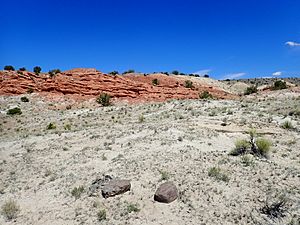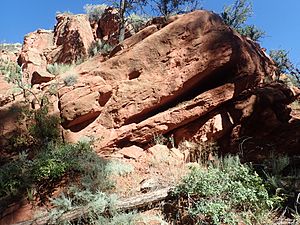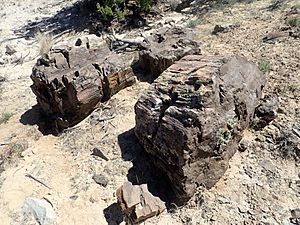Galisteo Formation facts for kids
Quick facts for kids Galisteo FormationStratigraphic range: Duchesnean ~42–38Ma |
|
|---|---|

Galisteo Formation near Espinaso Ridge, New Mexico
|
|
| Type | Formation |
| Underlies | Espinaso Formation |
| Overlies | Diamond Tail Formation |
| Area | Galisteo Basin |
| Thickness | 979 m (3,212 ft) |
| Lithology | |
| Primary | Sandstone |
| Other | Mudstone |
| Location | |
| Coordinates | 35°23′29″N 105°58′36″W / 35.3914561°N 105.9767794°W |
| Approximate paleocoordinates | 37°24′N 97°24′W / 37.4°N 97.4°W |
| Region | New Mexico |
| Country | |
| Type section | |
| Named for | Galisteo Creek |
| Named by | Hayden |
| Year defined | 1869 |
The Galisteo Formation is a special layer of rocks found in New Mexico. It's a geologic formation, which means it's a distinct set of rock layers that geologists can identify and map. These rocks contain fossils from a time called the Bartonian stage of the Eocene epoch. This was about 42 to 38 million years ago.
Contents
What is the Galisteo Formation?

The Galisteo Formation is mostly made of sandstone (like hardened sand) and mudstone (like hardened mud). It also has smaller amounts of conglomerate (rocks with pebbles), freshwater limestone, and tuff (rock made from volcanic ash). These rocks formed from ancient rivers and streams that flowed across the land.
You can see these rocks in certain areas between Sandia Crest and the southern Sangre de Cristo Mountains. There's also a smaller area where they appear near the Jemez Mountains. The Galisteo Formation slowly changes into the Espinaso Formation above it. Below the Galisteo Formation, you'll usually find the Diamond Tail Formation.
Scientists have found older rock pieces from the Precambrian and Paleozoic eras at the bottom of the Galisteo Formation. This suggests that big movements in the Earth's crust, called tectonic shifts, created a break between these rock layers. The formation itself shows signs of bending and shifting while it was still forming. This might have happened because the southern Sangre de Cristo Mountains were growing taller at that time. The thickest part of the formation is about 979 meters (3,212 feet) deep.
By looking at the way the sand grains are arranged, scientists can tell which way ancient rivers flowed. The sand came from ancient mountains to the northeast and northwest, like the Nacimiento Mountains. There's no sign of sand coming from the area of Sandia Crest. This suggests that Sandia Crest wasn't uplifted (pushed up) until after the Eocene epoch.
Ancient Life: Fossils in the Galisteo Formation
The most important place for finding fossils in the Galisteo Formation is a quarry called Stearns quarry at Arroyo del Tuerto. Here, scientists have found many titanothere fossils. Titanotheres were huge, rhino-like mammals that lived about 42 to 38 million years ago.
Petrified wood is also found in this area. Petrified wood is wood that has turned into rock over millions of years. Other than these finds, the Galisteo Formation doesn't have many other fossils.
What Fossils Have Been Found?
Here are some of the types of fossils discovered in the Galisteo Formation:
Mammals
- Carnivores
- Angelarctocyon cf. australis (an ancient meat-eater)
- Glires (like rodents)
- Paramyidae indet. (an ancient rodent family)
- Pantodonts
- Coryphodon sp. (a large, early mammal)
- Perissodactyls (odd-toed hoofed mammals)
- cf. Homogalax protapirinus (an early tapir-like animal)
- Brontotheriidae indet. (ancient rhino-like mammals)
- Equidae indet. (ancient horse family)
- Placentals
- Hyopsodus powellianus (a small, early hoofed mammal)
- Primates
- Microsyopidae indet. (an ancient primate family)
- Theriiformes
- Ectoganus sp. (an ancient mammal with strong claws)
How Scientists Studied the Galisteo Formation
The Galisteo Formation was first described by a scientist named F.V. Hayden in 1869. He was on an expedition to New Mexico and Colorado. He called it the "Galisteo sand group." He noticed that its sandstone layers were tilted at different angles and came in colors from off-white to brick red. He didn't find any fossils besides huge pieces of petrified wood.
Originally, this formation included some older rock layers. But in 1997, scientists realized these older layers were quite different. They were separated by a significant break in the rock record, called a disconformity. So, these older layers were then given their own name: the Diamond Tail Formation.


